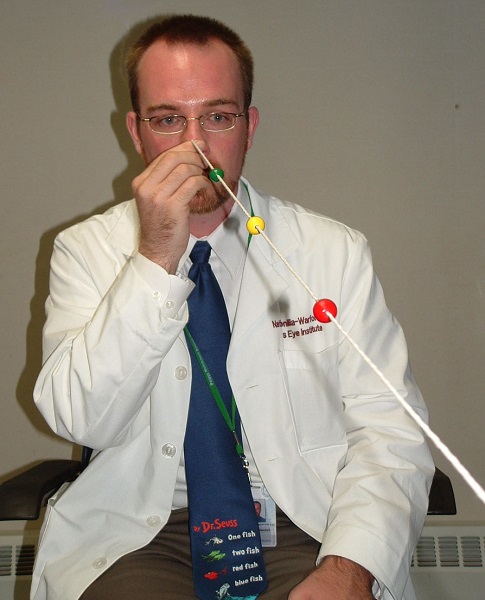Imagine for a moment the weatherworn seafaring pirate of old. What distinguishing characteristic comes to mind? It’s the eyepatch, of course. But have you ever wondered why these fearless buccaneers wore eyepatches?

While co-presenting about virtual-reality vision health issues at a recent conference with Dr. Michael Duenas, the Chief Medical Officer of the American Optometric Association (AOA), I encountered an ironic and novel explanation. Speaking playfully, Dr. Duenas postulated that rather than wearing an eye patch due to the loss of an eye in a fierce pitched battle, there may be another reason entirely as to why these freebooters sported their ever-intimidating eyepatches. Perhaps, he posited, our fierce sea robbers wore cloth eyepatches because they suffered from double vision, and used the eyepatch to bring their visible world back into singular alignment. You see, it is much safer to navigate around one rock rather than two (which one is real?). And, of course, it makes a big difference if our vessel is being chased by one corsair rather than two. (Maybe we would consider turning around to fight.)
Next let’s fast-forward to the modern world of virtual reality in education. Surprisingly, our swashbuckling pirate story continues here. In my recent Display Daily article entitled “Vision, VR and Discomfort: An Educational Audit“, I described how I combed the ISTE 2017 conference in search of modern-day Blackbeards—educators, vendors, and students—who were facing vision challenges when viewing virtual reality educational simulations. (The ISTE 2017 educational technology conference held in late June, with over 15,000 educators in attendance, is considered the largest ed-tech conference in the U.S. Every state and more than 72 countries were represented at this year’s ed-tech extravaganza.) I found many vision-hampered, modern day flibustiers, most notably a group of students from Mexico who had integrated VR components into their studies and were there to present their accomplishments. Of the ten students present, seven had no problems viewing or using VR. Yet three students of the ten could not view VR without getting sick.
Bright, exuberant students from Mexico City
That finding squares with a recent survey I conducted in my undergraduate classes this semester at the University of Colorado-Denver. Of the twenty-seven survey participants, over 17.9% indicated that “VR tends to make me sick.” In coping with this challenge, many vendors and educators offer a predictable explanation: as the technology improves, “this problem will go away.” One researcher presenting at ISTE 2017 put it this way:
“The display latency and energy consumption affect the overall performance of VR devices. Also, lack of movement and health concerns related to low resolution [become a] restraining factor for the growth of the market.”
Over the years, I have heard many such arguments. These arguments presuppose that virtual-reality vision problems are caused by excessive motion, pixelation issues, display latency, hardware and/or resolution quality. These might be important issues, but they do not line up with recent medical insight. You see, I control for these technical issues in my undergraduate classes and still I observe VR viewing-related vision problems ranging from 18 to 21%. International vision health evidence tells us the real story: that over 14% of any population will have a range of difficulty viewing stereoscopic virtual reality content, with those numbers being even higher in less-developed or low-economic environments. You can improve the technology all you want, but unless you pay attention to the user’s eyes, the problem won’t disappear.
The ISTE 2017 VR and 3D Panel
One of the most strikingly successful presentations at the ISTE 2017 conference involved a panel I put together featuring the work of Payod Panda, Michael Fricano, Jr., Joy Schwartz, and me. After our brief panelist presentations, we separated into interest groups, with members of the audience breaking out into the group of their choice.
About eleven attendees found their way to my  breakout presentation, which offered to explain why some students and teachers struggle with viewing VR and what we can do about it. Returning to our earlier Jolly Roger theme, I used a “pirate string” (a friendly adaptation of the “brock string” by Dr. Michael Duenas) in our breakout group to demonstrate why some students might struggle with viewing virtual reality under any circumstances. Here is how it all works: in order for a student to comfortably view virtual reality or any type of 3D stereoscopic content, s/he must have eyes that cooperate. The student’s eyes must be able to simultaneously team, focus and track.
breakout presentation, which offered to explain why some students and teachers struggle with viewing VR and what we can do about it. Returning to our earlier Jolly Roger theme, I used a “pirate string” (a friendly adaptation of the “brock string” by Dr. Michael Duenas) in our breakout group to demonstrate why some students might struggle with viewing virtual reality under any circumstances. Here is how it all works: in order for a student to comfortably view virtual reality or any type of 3D stereoscopic content, s/he must have eyes that cooperate. The student’s eyes must be able to simultaneously team, focus and track.
The low-tech “pirate string” quickly enabled us to measure the ability of our eyes to team (work together) and focus. One might say it is like having our eyes “walk the plank” of virtual-reality without having to don actual headgear. Now three of our eleven participants (all educators) had previously experienced genuinely adverse reactions to virtual-reality viewing and thus avoided it whenever possible. The other attendees simply wanted to learn strategies to avoid this problem when it occurred in the classroom. After our demonstration using this primitively analog “pirate string” technique, all three vision-challenged participants (and all observers) could understand, for the first time and in a concrete/personal way, exactly why virtual-reality viewing might be extremely difficult for some students—and what they could do about it. Necessarily, I did not leave my breakout session participants without a reassuring remedy. (You can learn more about our medically vetted remedy in my past article, “Making VR Comfortable for Classrooms or Customers”.)
 The Brock String, a.k.a. the “Pirate’s String”
The Brock String, a.k.a. the “Pirate’s String”
It’s safe to say that display manufacturers, content developers, integrators and distributors now serving the educational VR marketplace would do well to both understand this issue and address it more efficiently than they do so now. Aargh! –Len Scrogan

